



Ultra 64 at the Shoshinkai Show |
|
NU 64 is no longer shrouded in unknowable mystery. In this, the new year of 1996, we will see perhaps the greatest event in gaming history with the release of Nintendo's next star platform. Everything we imagined about in the ultimate system was there at the Shoshinkai Show, also known as Space World, in Japan. This is an annual exhibition sponsored by domestic suppliers of Nintendo goods, sort of like a CES or E3 sans hedgehogs or geckos. Over Thanksgiving weekend '95, the Ultra 64 made its official debut to an astonished audience. As promised by Nintendo, this next-generation machine will indeed take us to a whole new level unparalleled in the home console market, exhibiting a technical breakthrough with astoundingly immaculate 3-D imagery and a revolutionary way to play. Many months have passed since August 23rd, 1993, when Nintendo and Silicon Graphics announced a joint development project to shape the next era of videogaming. Now, the secrecy of Project Reality is dashed to pieces. The unveiling of the system was led by a host of presenters, chiefly Nintendo President Hiroshi Yamauchi. He explained the system will be renamed Nintendo 64 in Japan, apparently due to trademarking issues in the Asian Market with the "Ultra" moniker. This rebranding is complete with an all-new logo resembling interspliced polygonal Ns in a three-dimensional shape. The Nintendo 64 shall release to the Japanese public on April 21st for 25,000 Yen, and, supposedly, a month later in America. Howard Lincoln, Chairman of Nintendo of America, since confirmed the price will be under $250 when this magical machine finally lands in the states. |
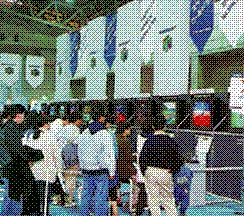
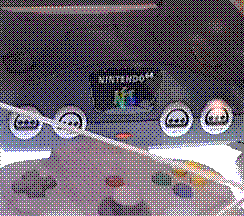
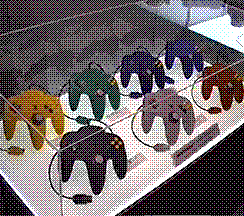
Huge Crowds at Shoshinkai Actual Ultra 64 In Real Life! Assortment of NU64 Gamepads |
|
The hardware shown off was spectacular, however the real proof of Nintendo's ingenuity shines with the innovative game-changing controller. Seeking to renovate game control altogether, and ideally to improve a player's sense of interactivity in any given virtual environment, the Ultra 64's gamepad is unlike anything seen before. First, it is undeniably huge - naturally, considering its aspiration to reshape gaming as we know it. It has a standard SNES-like cross-pad on the left-hand side, and six face buttons on the right: Two main "A" and "B" buttons plus four smaller yellow keys with directional imprints. Left and right shoulder buttons are also present, as is a traditional Start key. Taking main stage, as some analysts predicted, is a third grip placed in the direct center of the controller that holds the Analog Stick. This thumb stick is designed to allow full 3-D play control with surgical precision. If the final product is true to this vision, it may allow for true 360-degree movement at all angles. The only caveat to this control scheme is the mandated shift in hand positioning to the middle and right handles. This may be awkward at first, but, according to Nintendo's intent, this will allow for multiple methods for holding the controller depending on the game and its designers. Underneath the third arm is a stealth "Z" button meant to resemble a gun's trigger, for use with the left index finger when also using the thumb stick. A vacant slot is included beneath all NU64 controllers which may be used for memory cards. One may, theoretically, save game and controller info to the card, then carry that data to a friend's house within the controller itself. |
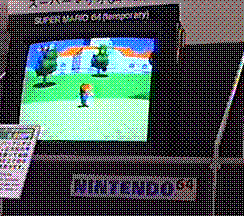
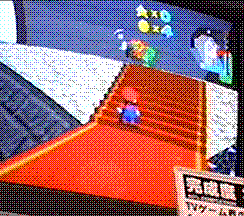
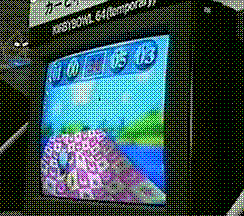
SM64 In All Its Glory! Mario's Total 3-D World A Rolling Kirby on NU64 |
|
The Ultra/Nintendo 64 may be the most powerful system ever, with a revolutionary controller to boot, but the innovative games displayed were what captured the imagination of an eager public. Over 100 64-Bit machines were available for use by the Shoshinkai crowd, each showcasing two playable prototypes. The headliner was the absolutely awe-inspiring Super Mario 64. If early reactions are any indication, it will be the reason early adopters wait in line to purchase an Ultra 64. Watching a fully realized 3-D Super Mario, animated brilliantly with an assortment of moves and abilities, roam around a limitless 3-D space is other worldly. Series creator Shigeru Miyamoto created true virtual reality. Years from now players and game enthusiasts will look back on SM64 as the title that defined a new chapter in gaming history and totally redefined 3-D games. Super Mario 64 represents a shocking departure from traditional Mario gameplay, and we mean that in the best way. Every sight can be explored, any landscape can be interacted with, and, yes, all enemies can be decimated. In the words of Mr. Yamauchi himself, "I might be bragging, but when this game is complete, it may be the best video game in history." The other demo on display was for Kirby Bowl 64, an evolution in the Dream Course formula likewise rendered in lifelike 3-D. About 11 titles were also briefly demonstrated in a snappy clip show, among them being Pilotwings 64, Goldeneye 007, Star Fox 64, Mario Kart R, and The Legend of Zelda (My personal most anticipated pick, even if the clip lasted 3 seconds -Jet). Full previews of the brand-new Mario, Kirby, and Pilotwings entries are viewable at the PPM Preview Corner, with expanded looks at the other games next issue. Mr. Yamauchi went on to discuss another curious component to the Nintendo 64, a magnetic disk system nicknamed the "Bulky" storage device. This proprietary, non-CD drive technology was proclaimed by the company president as a high volume, super-speed replacement for CD-ROMs. Few additional details were divulged, however Mr. Yamauchi did slip in that Zelda 64 (working title) will be one of the first games to use it! Though the event concluded with most in high spirits, some questions remain. Why did Nintendo not let the Space World crowd try out some of the other titles, as they originally indicated would be the case. And why was more information not provided about the cartridge alternate? Until we learn more about this storage experiment, the Big N may yet remain a step behind Sony and Sega in the eyes of game developers. |
 [Article from the January 1996 Issue of PPM] |


Click the Arrow Blocks to Navigate Through Our Spotlight Features


